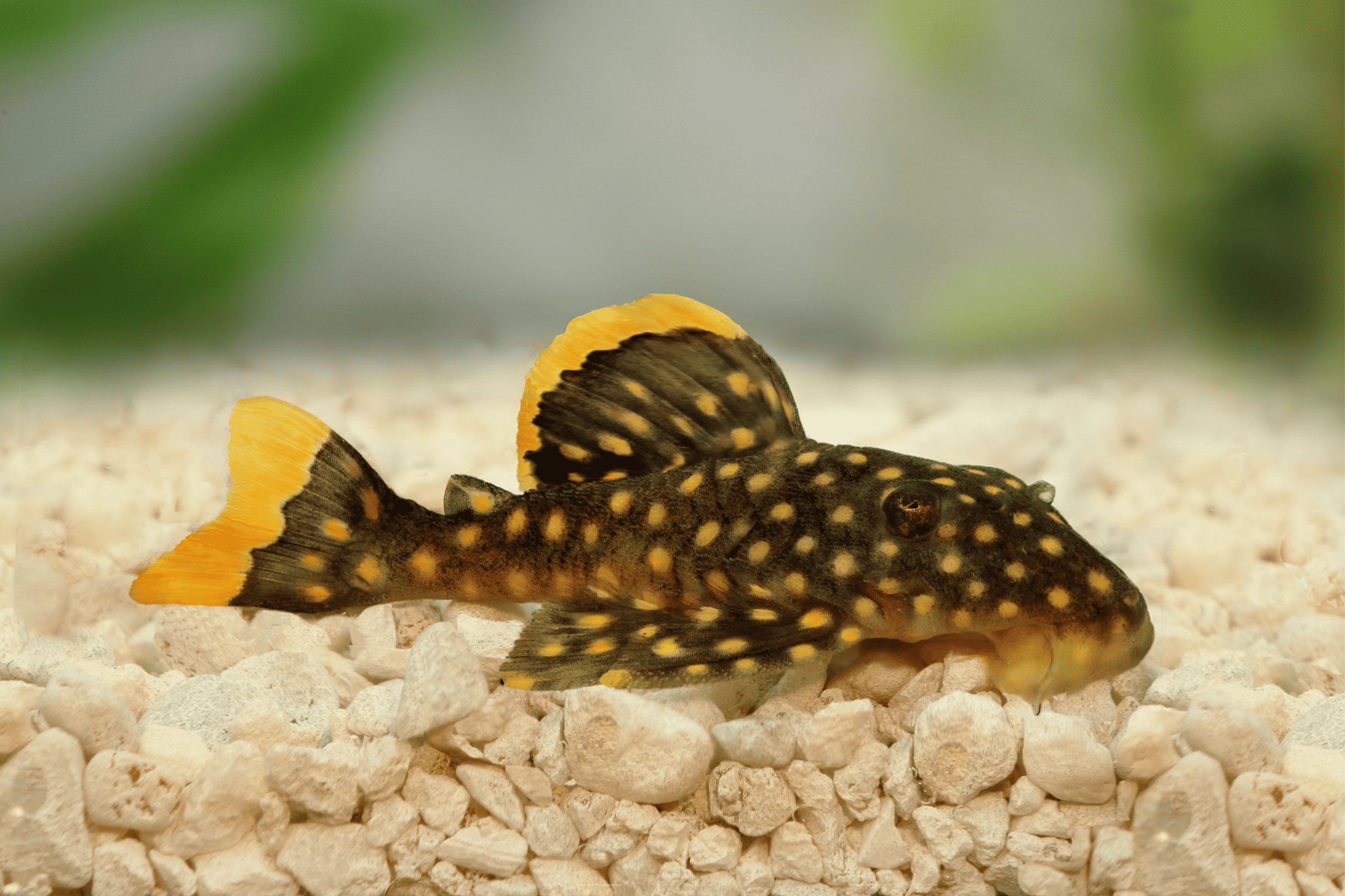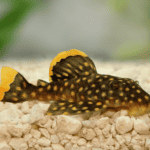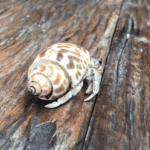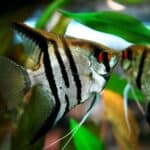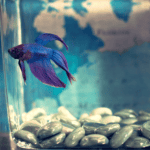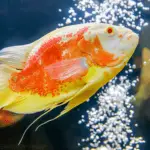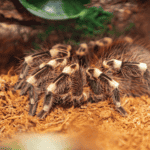Plecostomus, commonly known as plecos, are a popular choice among aquarium enthusiasts due to their algae-eating tendencies and unique appearance. As omnivorous fish, a well-balanced diet is essential for their growth and overall health. Ensuring your pleco gets the right mix of plant and meat-based foods will lead to a happy and thriving fish in your tank.
One of the staple foods for plecos is algae wafers, which are specially formulated to provide ample nutrition and sink to the bottom of the tank for easy access. These wafers often contain vegetables, making them a great choice to fulfill your pleco’s plant-based dietary needs. To complement the wafers and provide protein, a mixture of live or frozen foods, such as earthworms, bloodworms, and shrimp, is highly recommended.
Feeding your pleco fresh fruit and vegetables, like zucchini, peas, and cucumbers, can further enhance their diet and promote optimal growth. Regularly rotating different food types helps maintain a balanced diet and provides the plecos with a variety of taste sensations, encouraging them to stay healthy and vigorous throughout their lives.
Understanding Plecos
Pleco Species
Plecos, also known as pleco catfish or suckermouth catfish, are a diverse group of freshwater fish belonging to the Loricariidae family. There are over 150 species, varying in size, color, and appearance. Some popular pleco species include the Sailfin Pleco, Bristlenose Pleco, and the Common Pleco.
Pleco Habitats
Plecos are native to Central and South American river systems, where they typically inhabit slow-moving or still waters with ample vegetation and hiding spots. In an aquarium setting, replicating their natural habitat is essential for ensuring their well-being.
- Provide plenty of hiding spots, such as caves, PVC tubes, and plant coverage
- Use a substrate that offers stable and natural footing for your pleco
- Maintain water conditions within appropriate parameters: temperature between 72°F to 82°F (22°C to 28°C), pH between 6.5 to 7.5, and proper filtration to maintain water quality
Nocturnal Behavior
Plecos are nocturnal animals, meaning they are predominantly active during the night. As such, they require hiding spots to rest during the day and prefer dimly lit environments. This nocturnal behavior directly impacts their feeding habits, with many plecos foraging for food under the cover of darkness. Providing a nocturnal-friendly environment can promote a pleco’s natural instincts and encourage healthy behavior.
Feeding Plecos
Feeding Schedule
Plecos require a varied diet to ensure they receive proper nutrition for growth and overall health. Their feeding schedule may vary depending on their age, size, and species. In general, young plecos can live on the algae present in the tank, supplemented with algae wafers. As they grow, you will need to expand their diet.
Here are some food options for plecos:
- Algae wafers: These are a staple in most pleco diets.
- Vegetables: Plecos can benefit from consuming vegetables such as zucchini, spinach, and cucumber.
- Fruits: Fresh fruits like apples and pears can occasionally be offered.
- Meat: Occasionally provide your pleco with earthworms, bloodworms, and shrimp. Choose between fresh or frozen varieties.
It’s important to note that plecos are nocturnal, which means they are more active during the night. As such, it’s best to feed them in the evening, as this is when they will usually search for food.
Overfeeding Precautions
Overfeeding can lead to health problems for your pleco, such as obesity and decreased water quality. To avoid these issues, here are some tips to keep in mind:
- Feed your pleco in moderate amounts. One round of food per day should be sufficient for most plecos.
- Monitor your pleco’s appetite closely and adjust portion sizes accordingly.
- Remove any uneaten food after 24 hours to maintain water quality.
Feeding your pleco a diverse and well-balanced diet while adhering to an appropriate feeding schedule will ensure a healthy and happy fish. By taking precautionary measures against overfeeding, you can also maintain a clean and healthy aquarium environment.
Dietary Requirements
Plecos have different dietary needs depending on their specific type. In this section, we will discuss the dietary requirements for herbivore, omnivore, and carnivorous plecos.
Herbivore Plecos
Herbivore plecos mainly feed on plants and algae, making them excellent algae eaters. Their digestive system is designed to efficiently extract nutrients from plant-based foods. To maintain a healthy diet for herbivore plecos:
- Provide a variety of plants and algae for them to graze on.
- Supplement their diet with algae wafers or pellets, which are available at most pet stores.
- Offer fresh vegetables such as zucchini, spinach, and cucumber, lightly blanched to soften the texture.
It is important to provide a varied diet with essential vitamins and minerals to ensure the overall health and growth of your herbivore pleco.
Omnivore Plecos
Omnivore plecos consume a combination of plant-based foods and animal matter. Their dietary requirements include:
- Algae and plant matter, similar to herbivores, to support their digestive system.
- Meaty foods such as earthworms, bloodworms, and shrimp, which can be found at pet shops and fish stores, and may be offered fresh or frozen.
- Fresh vegetables and fruit, while not a primary part of their diet, can be provided occasionally.
A varied diet, including the aforementioned items, ensures that omnivore plecos receive a balanced intake of nutrients for optimal health.
Carnivorous Plecos
Carnivorous plecos primarily consume animal-based foods. Their diet should consist of:
- Protein-rich items such as shrimp, bloodworms, and other small aquatic animals.
- Some plant matter or vegetables to provide a balanced diet, even if animal-based foods form the majority of their nutritional intake.
Carnivorous plecos require a higher proportion of animal-derived nutrients than herbivores and omnivores, so tailoring their diet accordingly is essential for proper growth, health, and well-being.
Vegetable Options
Plecos are omnivorous freshwater fish that enjoy a variety of vegetables in their diet. Providing your pleco with healthy vegetable options can help ensure their overall wellbeing and proper growth. Some common vegetables to offer plecos include zucchini, lettuce, cucumber, kale, broccoli, lima beans, celery, and cabbage.
Leafy Greens
Leafy greens are rich in vitamins and minerals, making them an excellent choice for plecos. Some of the leafy greens suitable for plecos are:
- Lettuce
- Kale
- Spinach
To feed leafy greens, clean the leaves thoroughly and blanch them briefly in hot water before cooling and submerging them in the tank. This will soften the leaves, making it easier for plecos to eat.
Cruciferous Vegetables
Cruciferous vegetables are another nutritious option for plecos, providing them with essential nutrients:
- Broccoli
- Cabbage
In order to feed cruciferous vegetables, blanch them for a few minutes, then submerge them in cold water to stop the cooking process. This ensures that they are soft enough for plecos to consume while still retaining their nutritional value.
Root Vegetables
Root vegetables can also benefit your pleco’s diet when they are properly prepared. Some root vegetables that can be used as a food source are:
- Zucchini
- Cucumber
- Celery
To serve these root vegetables, cut them into thin slices and blanch them briefly before placing them in the aquarium. These vegetables will provide an additional source of nutrition, as well as give your plecos something to munch on.
In conclusion, keep in mind to use organic vegetables where possible to minimize the exposure of your plecos to harmful chemicals. Offering a varied diet of leafy greens, cruciferous vegetables, and root vegetables is crucial for maintaining plecos’ health and well-being.
Fruit Options
Plecos can benefit from the addition of fruits in their diet. This section will cover some suitable fruit options for plecos, such as melons and tropical fruits. Additionally, it will provide a list of acidic fruits to avoid, which might harm your pleco.
Melons
Melons, such as cantaloupe and honeydew melons, offer a good source of vitamins, minerals, and dietary fiber for your pleco. Some popular melon options for plecos are:
- Cantaloupe
- Honeydew Melon
To ensure proper digestion, cut the melon into small chunks and remove the seeds. You can either attach the pieces to a veggie clip or allow them to sink to the bottom of the tank for your pleco to enjoy.
Tropical Fruits
Tropical fruits such as breadfruit and papaya are also suitable for plecos. These fruits are packed with essential nutrients and are often enjoyed by plecos. Some recommended tropical fruits for plecos include:
- Breadfruit
- Papaya
Similar to melons, ensure that you remove any seeds, and that the fruit is cut into small pieces before feeding to your pleco.
Acidic Fruits to Avoid
Some fruits have higher levels of acidity, which might be harmful to your pleco. It’s crucial to be aware of these fruits and avoid feeding them to your pleco. Some of the acidic fruits to avoid are:
- Tomatoes
- Citrus fruits (e.g., oranges, grapefruits)
- Pineapples
- Strawberries
Remember to keep variety in your pleco’s diet by combining fruits with other food sources such as vegetables and protein options. This will help ensure your pleco receives all the necessary nutrients for optimal health.
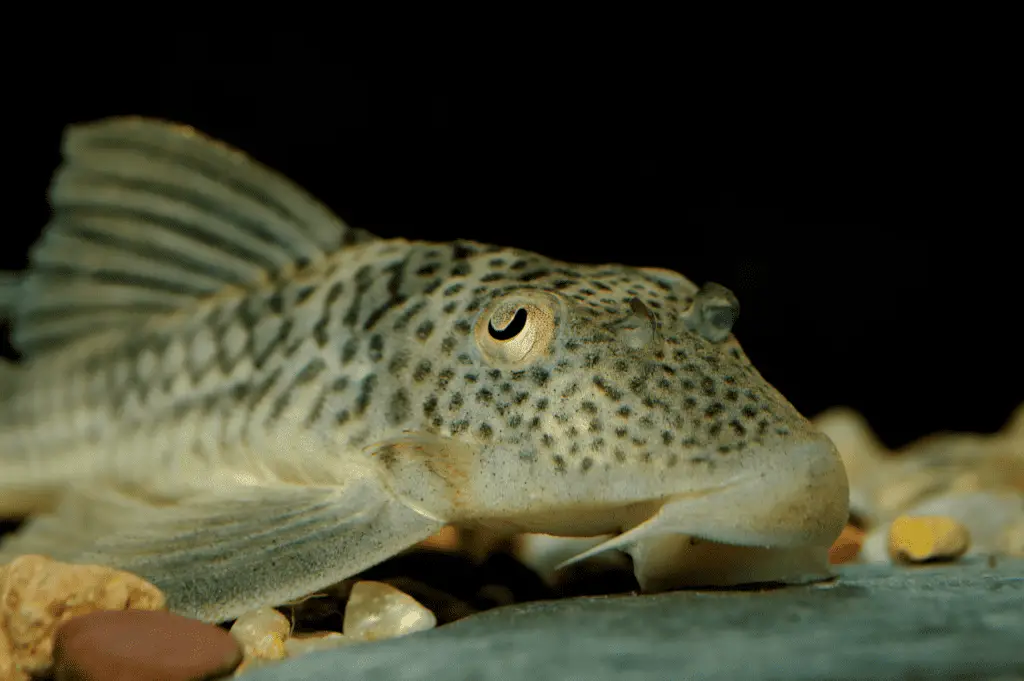
Alternative Food Sources
In this section, we will explore alternative food sources for your Plecos to ensure they receive a well-rounded diet.
Driftwood
Not only does driftwood serve as an excellent aquascape element in your aquarium, but it also provides an essential food source for Plecos. They need driftwood to assist with their digestion and overall well-being. Some Plecos love to gnaw on driftwood and consume the wood fibers as part of their diet. To offer this beneficial food source, include a small piece of driftwood in your Plecos’ tank.
Algae Wafers
Algae wafers are an excellent supplementary food source for Plecos. These wafers contain a high content of plant-based materials, such as seaweed, dried spirulina, and plankton. They provide various nutrients, including 35% protein, 5% fiber, 6% fat, and 6% moisture. You can feed your Pleco algae wafers in addition to their regular diet to offer a balanced and nutritious meal.
Sinking Pellets
Sinking pellets are another valuable alternative food source for Plecos that can easily reach the bottom of the tank. Incorporate sinking pellets containing a high percentage of vegetables, such as Tetra Algae Wafers, which are vegetable-fortified and provide an easy-to-digest, fiber-rich nourishment for your bottom-feeding Plecos.
Live and Frozen Foods
Plecos thrive on a varied diet that includes live and frozen foods. Some options in this category are:
- Earthworms
- Brine shrimp
- Frozen or freeze-dried bloodworms
These foods provide essential proteins and nutrients that support the overall health and growth of your Plecos.
Snails
Some Plecos enjoy eating snails, which can be a natural and healthy addition to their diet. Snails serve as a source of protein and nutrients that Plecos may not obtain from other food sources. Be cautious when introducing snails into your Plecos’ tank, as they could potentially contaminate the water if not properly managed.
Remember to offer a variety of food sources to your Plecos for optimal health and growth. Mixing driftwood, algae wafers, sinking pellets, live and frozen foods, and snails ensures that they receive a balanced and nutritious diet.
Commercial Foods
Hikari Tropical Algae Wafers
Hikari Tropical Algae Wafers are a popular option for pleco fish, providing a well-rounded diet. These wafers contain various ingredients, such as seaweed, carrots, squash, broccoli, dried spirulina, plankton, and spinach, combined with vitamin supplements and minerals. The composition of the wafers includes 35% protein, 5% fiber, 6% fat, and 6% moisture, which ensures your fish stay healthy and well-fed.
These algae wafers are designed to meet the dietary requirements of plecos, and they are easy to digest. To feed your plecos, simply drop the appropriate amount of wafers into the tank. The wafers will sink to the bottom, allowing plecos to graze on them at their leisure.
No products found.
Omega One Veggie Rounds
Omega One Veggie Rounds are another excellent food choice for plecos. They contain a balance of both plant-based ingredients and protein sources, making them suitable for omnivorous plecos. These veggie rounds provide vital nutrients and fiber needed for plecos to thrive and maintain a healthy digestive system.
In addition to high-quality vegetable ingredients, these rounds also include whole salmon, halibut, and other seafood to provide a good balance of protein in the pleco’s diet. Omega One Veggie Rounds are formulated with a natural binder that keeps the pellet together, ensuring that it does not break apart in the water and contribute to poor water quality.
To feed your plecos, simply drop the recommended amount of veggie rounds into the tank, and they will settle on the bottom for the plecos to feed on.
- UNSURPASSED NUTRITION: Veggie Rounds are loaded with fresh ocean kelp hand harvested in Alaska! They are rich in Omega 3 & 6 HUFA's to support strong immune systems, and contain Spirulina, a powerful cyanobacterium that eliminates internal bacteria and pathogens
- SUPERIOR QUALITY: No meals, hydrolysates, digests, or any other pre-processed protein
- KEEP A CLEANER TANK: Our Veggie Rounds are naturally insoluble, which reduces water pollution, and they have significantly less starch, which reduces fish waste
- INSTRUCTIONS: Feed 1-2 rounds daily, or as much as can be consumed in 4 hours. If uneaten food remains after 4 hours, remove it and begin to feed a smaller amount
- GUARANTEED ANALYSIS: Min Crude Protein 35% / Min Crude Fat 10% / Max Crude Fiber 4% / Max Moisture 8.5% / Max Ash 9%
| Name | Highlight | Composition |
|---|---|---|
| Hikari Algae Wafers | Seaweed, vegetables, vitamins | 35% protein, 5% fiber, 6% fat |
| Omega One Veggie Rounds | Vegetables, seafood | Balanced proteins and fibers |
Remember to feed your plecos a balanced diet, incorporating a mix of commercial foods like Hikari Tropical Algae Wafers and Omega One Veggie Rounds, as well as fresh vegetables to ensure they receive all the necessary nutrients.
Homemade Food Options
Preparing Vegetables and Fruits
Preparing homemade food for your pleco can be easy and cost-effective. Vegetables like broccoli, spinach, and zucchini are great choices for your pleco, providing essential nutrients and fiber. These can be blanched, sliced, and fed to your fish:
- Blanch vegetables in boiling water for about 30 seconds
- Remove, cool, and slice into appropriate sizes for your pleco
Fruits such as watermelon, cucumber, and peas are also suitable options for plecos. To prepare:
- Remove seeds and skin when applicable
- Slice or crush fruits to a manageable size for your pleco
Creating Balanced Diets
To ensure a balanced diet, remember that plecos are omnivores, meaning they eat both plants and animal-based food:
- Combine vegetables with protein sources like shrimp, earthworms, and bloodworms
- Provide both fresh and frozen varieties of meaty foods
- Alternate between different plant-based and animal-based foods to offer variety
Adding Vitamins and Fiber
Ensuring your pleco gets enough fiber is crucial for preventing constipation. Here’s how to add fiber and vitamins to their diet:
- Incorporate a variety of vegetables and fruits for natural fiber sources
- Add Tetra Algae Wafers or similar products to provide vegetable-based food with ample fiber content
- Offer supplements containing vitamins K and A to support your pleco’s overall health
By following these guidelines, you can create a healthy and balanced homemade diet for your pleco, avoiding an overreliance on processed foods and ensuring they receive adequate nutrients and fiber.
Aquarium Environment
Water Quality and Parameters
Maintaining optimal water quality is crucial for the health of a pleco. Here are the essential parameters to keep in check:
- Temperature: 72-86°F (22-30°C) depending on the species
- pH: 6.5-7.5
- Ammonia, Nitrite, Nitrate: as close to 0 ppm as possible
Perform regular water changes to ensure optimal water quality and reduce the build-up of harmful wastes.
Air Circulation
Ensuring proper air circulation is vital for the health of your pleco, as they require well-oxygenated water. To achieve this, install an air pump with an air stone or sponge filter. Additionally, using a powerhead or a canister filter with a spray bar can create more water surface movement, promoting adequate gas exchange.
Plants and Hiding Spots
Providing hiding spots and a comfortable environment is crucial for plecos. They love to hide and rest during the day, becoming more active at night. Some ideal hiding spots include:
- Driftwood (especially for the clown pleco, which feeds on the wood)
- PVC pipes
- Clay caves or terracotta pots
- Large rocks or slate formations
Include live plants in your aquarium to create a more natural environment, such as Java fern or Anubias, which can also provide additional hiding spaces.
In addition to addressing the mentioned factors, plecos thrive when they receive a balanced, nutritious diet that meets their unique needs. Incorporate different types of foods, such as:
- Algae wafers or pellets
- Fresh vegetables like spinach, cucumber, or zucchini
- Occasional protein sources like bloodworms or brine shrimp
For algae-eating plecos like the brown algae consuming species, ensure your aquarium contains a sufficient amount of algae for them to graze on. Regularly monitor your pleco’s health and adjust its diet as needed to keep them happy and thriving.
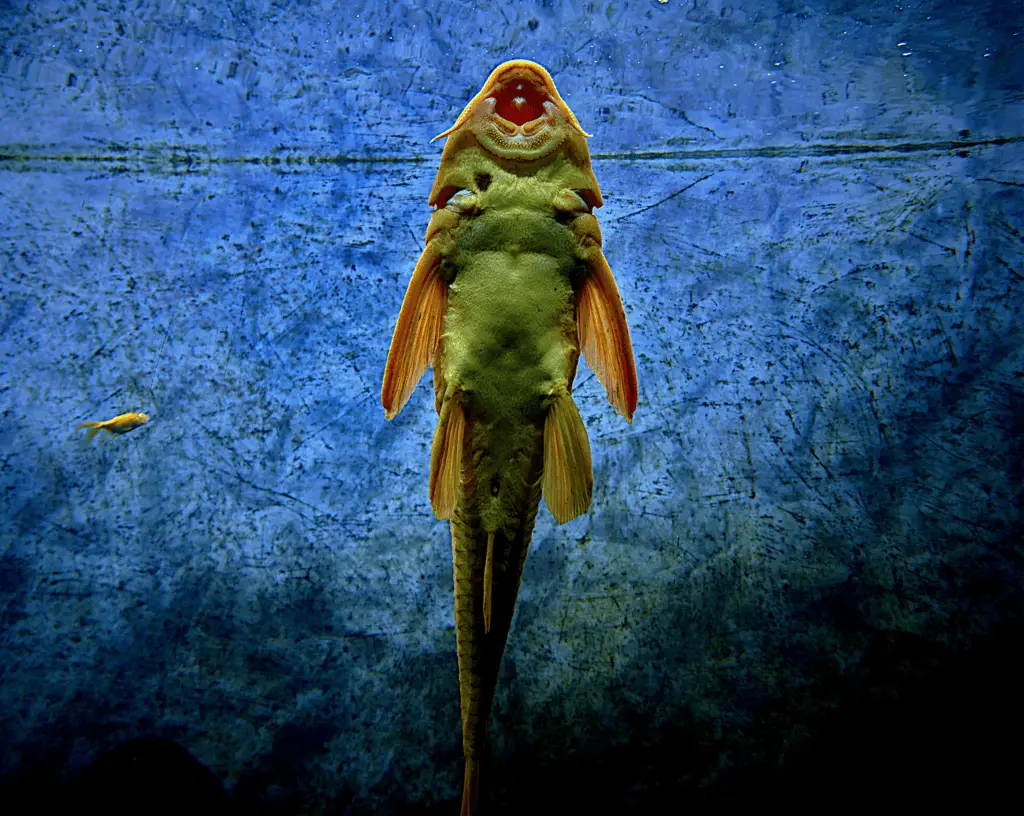
Caring for Specific Plecos
In this section, we will be discussing the care and feeding requirements for two popular types of plecos: the Bristlenose Pleco and the Common Pleco.
Bristlenose Pleco
The Bristlenose Pleco is a smaller species of plecostomus, growing up to 4-6 inches in length. They are generally low-maintenance, making them a popular choice for beginner aquarists. Here are some feeding tips for Bristlenose Plecos:
- Varied diet: A healthy diet for Bristlenose Plecos should include a mix of algae wafers, vegetables, and occasional protein sources like bloodworms or brine shrimp.
- Vegetables: Bristlenose Plecos love vegetables such as zucchini, cucumbers, spinach, and peas. Be sure to blanch hard vegetables before placing them in the tank.
- Algae control: While Bristlenose Plecos are good algae eaters, it is important to provide them supplemental food to ensure they are getting the proper nutrition.
Common Pleco
The Common Pleco is a larger fish, reaching up to 13-19 inches long, and requires a minimum tank size of 100 gallons. Despite their size, they are suitable for beginners who have appropriately-sized aquariums. Consider these feeding recommendations for Common Plecos:
- Wafers: Provide a mix of algae wafers and sinking pellets as a staple in their diet. Tetra Algae Wafers are a popular option, containing a blend of vegetables and fibers essential for optimal growth.
- Vegetables: Like the Bristlenose Pleco, Common Plecos benefit from the addition of vegetables in their diet. Seaweed, carrots, squash, and broccoli provide vitamins and minerals for overall health.
- Additional nutrients: Common Plecos can be offered occasional protein sources, such as frozen bloodworms or brine shrimp.
Remember that both Bristlenose and Common Plecos require clean water and proper tank maintenance to thrive. Providing a well-balanced diet will help ensure their health and longevity in your aquarium.
